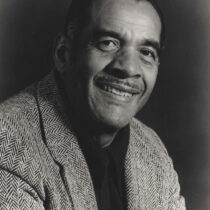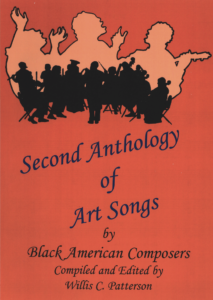Magazine

Lifting His Voice
Willis C. Patterson’s newly donated papers at the Bentley document a tireless fight for African American music to take its rightful place in the vocal canon.
In 1965, Willis Patterson was a young, talented Fulbright Scholar who was singing in “Amerika Houses” across Germany. Each night he’d perform Brahms, Schubert, and Italian opera to rave reviews.
That is, until a reviewer in the town of Bad Godesberg questioned why Patterson, an African American performer from the United States, would come to Germany “to sing repertory that Germans have already heard many times by equally (and often more) competent singers.” The reviewer suggested instead that Patterson perform “songs of his own racial heritage and from his own country; songs from Broadway musicals, folksongs, spirituals, and art songs.”
Patterson was shocked and upset. In his autobiography, The Unlikely Saga of a Singer from Ann Arbor, Patterson writes how he felt the reviewer’s words were “designed to put me in my place as a ‘proper’ Black singer.”
As he reflected on the remark, however, he realized there was some merit to it. “I thought the criticism was, indeed, legitimate in that the concert did not contain music from my own heritage.” However, he bristled at the idea of performing spirituals, Broadway songs, or the few art songs he knew from white composers.
But art song compositions from African American composers? Those piqued his interest.
Patterson’s decision to research and sing African American art songs would propel his performances and work in new directions. It would change the curriculum at U-M’s School of Music, Theatre, and Dance (SMTD) in perpetuity. Decades later, after a distinguished career as a scholar, performer, administrator, and teacher, Patterson’s materials showcasing the discovery and the history of African American art songs would be archived at the Bentley Historical Library, along with other materials from his extraordinary achievements.
The Bentley welcomed Patterson’s materials in September 2020 through a virtual event held in conjunction with the African American Music Conference. The event celebrated Patterson’s 90th birthday and honored his extraordinary contributions as well as the music he helped bring out of obscurity—and now, into the archive.
An Epiphany for Me
Patterson was born in Ann Arbor in 1930 and, at age 19, joined the Air Force in part to obtain money for a college education through the G.I. Bill.
In 1954, he transferred to the U-M School of Music from Eastern Michigan University (then called the Michigan State Normal College) without any formal music training. However, he thrived at U-M and graduated in 1958 with a bachelor’s degree in voice performance, then went on to complete a master’s degree in music in 1959. He was offered and accepted a job at Southern University in Baton Rouge, Louisiana, and moved there with his wife, Frankie Bouyer, a mathematics teacher whom he married in 1958.
Patterson says he relished being surrounded by Black colleagues at Southern University. “I was born and raised in Ann Arbor where persons of academic accomplishment of my color were rare,” he says. “This was an epiphany for me.”
He taught at Southern University for two years, then became a professor at Virginia State College in Petersburg, Virginia.
By 1965, he was in Germany on his Fulbright Scholarship. Mere weeks after his upsetting review in the Bad Godesburg paper, he performed two African American art songs—“Songs to a Dark Virgin” by Florence Price and “Soliloquy” by John W. Work—for the first time in front of a German audience.
Patterson writes that he became “committed to the goal of developing my own collection of African American art songs with the hope that such an effort might begin the process of filling a void.”
Changing the Canon
An art song is, by definition, written by a composer who uses poetry as the basis for the lyrics, then uses instrumental accompaniment to support the lyrics, thereby creating a song that is a unified whole. (Compare this with a folk song, for example, where the lyrics or melody might change spontaneously.)
There were plenty of African American art songs when Patterson went searching for them in the late 1960s and early ’70s— but they were difficult to find. The only book on the subject had been written in 1947 by a Detroit Public Schools teacher named Edgar Rogie Clark. Patterson reached out to Clark, along with myriad others, scouring archives, libraries, and private collections for songs.
In 1968, he returned to Ann Arbor to become the first African American faculty member in the history of the School of Music, Theater and Dance. By 1972, he had a collection of African American art music he felt could be published.
Patterson writes in Unlikely Saga that publishing African American art songs hadn’t been done by anyone at U-M or a comparable institution, and he felt it would contribute to the canon of music in a significant way.
 Patterson’s Anthology of Art Songs by Black American Composers was published by E.B. Marks Music Publishers in 1977.
Patterson’s Anthology of Art Songs by Black American Composers was published by E.B. Marks Music Publishers in 1977.
“When a collection as important as [this] comes along, it should stir more than the usual amount of interest in musicians of all varieties,” wrote Donald Ivey in Black Music Research Journal.
SMTD Professor Louise Toppin, who organized the African American Music Conference in Patterson’s honor, says that “this historic anthology continues to inspire the study of African American art song today as much as it did when it was first released.”
In 2002, Patterson self-published The Second Anthology of Art Songs by African American Composers, as well as a collection titled The New Negro Spiritual.
These works are part of Patterson’s lifelong advocacy for and contribution to a more diverse SMTD curriculum—a goal he worked toward during his 30 years as a SMTD faculty member, 20 of them as associate dean.
Among his many accomplishments, he instituted a course for voice majors to study music by African American composers. Toppin still teaches the course today.
“Historically, nowhere else in the country was there a course like this taken by music majors,” says Toppin. “Many other schools have not made this a priority.”
From 1969 to 1975 Patterson was the director of the U-M Men’s Glee Club. He served as president of the National Association of Negro Musicians and organized the first Black American Music Symposium at the University of Michigan in 1985. He also published The Saints Among Us, a book about the community of people in Ann Arbor who helped African American youths like himself during the Great Depression.
These activities and more are documented in his Bentley collection.
“The extraordinary breadth of Professor Patterson’s career makes his collection an invaluable addition to the holdings of the Bentley,” says Terry McDonald, director of the Bentley. “Any researcher will now be able to trace his search for African American art songs and other important contributions from his incredible career.”
“I am proud of my role in . . . the greater cultural and racial diversification of our [SMTD] community,” Patterson says. “I have gained a deep sense of pride in the role I have been permitted to play.”
